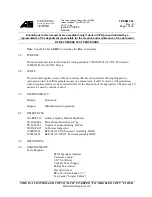
Bosch Security Systems | 2011-02
Praesideo 3.5
| Installation and User Instructions | EN54-16: 2008
en
| 31
Clause / Requirement
Compliance
Signature
7 The voice alarm condition
7.1 Reception and processing of fire signals
Praesideo is compliant.
7.1.1
The VACIE shall be capable of receiving and
processing alarm signals from the CIE or from manual
control on the VACIE or both, and causing the appropriate
voice alarm outputs to be activated within 3 s or on expiry of
any delay period (see 7.4).
Alarm signals from the CIE can be received from input
contacts and the Open Interface. Manual control is
possible via input contacts, the Open Interface and call
station (keypad) keys.
NOTE -
See Annex E for additional information relating to
the interface between the VACIE and the CIE.
If input contacts are used for connection of the CIE to the
Praesideo system then the input contacts can be monitored
for short circuit and open line. If the Open Interface is used
for connection of the CIE to the VACIE, the communication
is monitored using keep-alive messaging.
7.1.2
The mandatory indications and or outputs shall not be
falsified by multiple alarm signals received simultaneously
from the CIE and/or manual controls.
The Praesideo system offers 32 discrete alarm priorities.
Correct configuration assures that mandatory indications
and or outputs behave consistently when multiple alarm
signals are received simultaneously from the CIE and/or
manual controls.
Higher priorities overrule lower priorities in case of
resource or destination conflicts. Calls with the same
priority operate on first come first serve basis, except in the
case of priority 255: calls with the same priority 255
overrule each other, so the latest becomes active. This
assures that high priority microphones that are left behind
in an active state will never block the system.
7.1.3
Where the VACIE and CIE are in separate cabinets,
failure of the transmission path between the CIE and the
VACIE shall not result in any loss of control or any change
of state of the VACIE.
The Praesideo system is an autonomous subsystem that
can operate without connection to the CIE. The effect of
the failure of the transmission path between the CIE and
the Praesideo system is limited to fault reporting and losing
interaction between the CIE and the Praesideo system.
7.2 Indication of the voice alarm condition
Praesideo is compliant.
7.2.1
The presence of a voice alarm condition shall be
indicated on the VACIE, without prior manual intervention,
by:
a
a visible indication by means of a separate discrete light
emitting indicator (the General Voice Alarm Activated
indicator);
A voice alarm condition is indicated on the Praesideo
system by:
•
A red indicator on all call stations (the system
status LED).
•
A textual indicator on the network controller display
(the ‘emergency menu’ that is automatically shown
when the system enters the voice alarm state).
•
An output contact configured in the site specific
data as voice alarm activated indicator (Emergency
alarm indicator). This output contact can be used to
control the General Voice Alarm Activated
indicator.
•
The installer must mount a red (flash) light to
indicate the voice alarm condition, clearly visible
from the front side of the rack, behind the glass
door of the rack.
b
a visible indication for each activated voice alarm zone
where manual controls are provided (see 10.2);
The keys on call station keypads can be configured to have
their key indicator show that an emergency is active for a
specific zone or group of zones. This is achieved by
configuring the action ‘Zone status’ for the key, and
configuring the lowest possible alarm priority (224) for that
action to ensure that for all alarm priorities (224 - 255) the
indicator will be activated.
NOTE -
This may be by means of separate discrete
indicators or an alphanumeric display as specified in 13.8.
c
an optional audible indication, as specified in 7.3.
An output contact of a Praesideo system component can
be configured in the site specific data as audible voice
alarm activated indicator (Emergency alarm buzzer). This
output contact can be connected to a buzzer. This way the
voice alarm condition is indicated audibly.
7.2.2
The audible warning shall be capable of being
silenced at access level 1 or 2.
The connected buzzer (see 7.2.1.c) can be silenced by
acknowledging the voice alarm condition. The voice alarm
condition can be acknowledged by means of an input
contact, call station key, the front panel menu of the
network controller or via the Open Interface.
















































